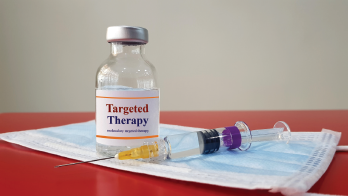
joel bubble ben / shutterstock.com
EULAR 2020 e-CONGRESS—In what speakers at the European e-Congress of Rheumatology described as the first treat-to-target and tight control (T2T/TC) strategy trial in axial spondyloarthritis (AxSpA), researchers found such a strategy has both health and financial benefits.
In the year-long study—called TICOSPA—centers were randomized to apply either a T2T/TC strategy or care left to the discretion of their rheumatologist, with 80 patients with AxSpA randomized to each arm, and 72 in each arm seen by researchers through to the study’s end. To be included in the study, patients must have had a diagnosis of predominant axial spondyloarthritis according to both the axial ASAS (Assessment of SpondyloArthritis International Society) criteria and the opinion of the treating rheumatologist, as well as have active disease (defined as an Ankylosing Spondylitis Disease Activity Score [ASDAS] of at least 2.1) and have been suboptimally treated with at least two non-steroidal anti-inflammatory drugs (did not have to be simultaneous) in the previous year.

Dr. Molto
Anna Molto, MD, PhD, a rheumatologist and researcher at Cochin Hospital, Paris, said rheumatologists approached patients in the treat-to-target group with a pre-defined strategy that included a treatment recommendation produced by an algorithm and treatment intensification until patients reached an ASDAS less than 2.1. Patients in the usual care group were managed according to physician discretion. Physicians using usual care were blinded to the treat-to-target strategy, with separate study meetings conducted. The study included 18 centers in France, Belgium and The Netherlands.1
The main outcome was a significant improvement of at least 30% in the ASAS Health Index (ASAS-HI), a measure of overall health among ankylosing spondylitis patients. Other parameters were assessed as secondary outcome measures.
Researchers saw no statistically significant difference between the two groups in the proportion of patients achieving 30% improvement in the ASAS-HI, although 11% more patients in the treat-to-target group reached that outcome—47% compared with 36% in the usual care group.

Dr. van der Heijde
Investigators did see significant improvements in several other domains in the treat-to-target group compared with those in the usual care group. These included changes in the ASDAS low-disease activity measure and the disease improvement measures ASAS40 and ASAS20, as well as the Bath Ankylosing Spondylitis Disease Activity Index (BASDAI) and the BASDAI 50. No significant improvements were seen in other measures, including the ASDAS inactive disease measure, the ASDAS partial remission measure and the physician global assessment.
The treat-to-target approach was found to be cost effective, with an incremental cost-utility ratio of €19,430 (or approximately $22,900 U.S.) per quality-adjusted life year.
Dr. Molto acknowledged the best outcome measure to examine in a comparison of treatment strategy is structural damage, but a trial with such an endpoint would take five to 10 years. The outcome chosen was intended to give a broad picture of the patient’s overall condition, she said.
“The main strength of this study was the decision to choose a primary outcome which was different from the target,” Dr. Molto said. “In previous studies in rheumatology for treat-to-target in rheumatoid arthritis and psoriatic arthritis, both the target and the outcome were based on the same domain—on disease activity. Here, we wanted to show an improvement—significant improvement—in another domain of the disease, quality of life, while targeting inflammation and disease activity.”
Identifying the Target
Maxime Dougados, MD, professor of rheumatology at Cochin Hospital and a lead investigator in the study, pointed out that treat-to-target studies are fraught with questions that must be handled delicately. The target of the treatment isn’t necessarily straightforward, he said, pointing out the many extra-spinal features of AxSpA, including peripheral arthritis, uveitis and psoriasis. Certain patients may be at greater risk for certain complications, depending on their history and comorbidities, he said.

Dr. Dougados
Once clinicians identify the domain to be targeted, they must take care to measure it properly. Many indices can be used to measure disease activity, for example, as well as cardiovascular risk factors.
Collecting and reporting outcome measures are critical, and many rheumatologists don’t routinely collect many of the relevant data points. A fellow studying at his center reviewed the electronic medical records of 30 rheumatologists in the Paris area, finding that less than 30% of patients had a recorded BASDAI, and less than 1% had a recorded ASDAS, Dr. Dougados said.2
As for the TICOSPA data, other trials will likely be needed before physicians get comfortable with a treat-to-target strategy. “In medicine, usually we are more comfortable when you have confirmation by two or three different strategy trials,” Dr. Dougados said. “Unfortunately, so far, I am not aware of other ongoing clinical trials in this area.”
Still, he said, a treat-to-target approach “is not only feasible, but has to be considered in axial spondyloarthritis for each patient. This approach has to be individualized, because of the possibility of different clinical presentations.”
Measuring Disease Activity
Désirée van der Heijde, MD, PhD, professor of rheumatology at Leiden University Medical Center, The Netherlands, who developed the ASDAS, said the measure was an appropriate target for the trial, saying that disease activity should be the target in such a strategy comparison and that ASDAS performs better than the BASDAI in many important areas. Developed in 1994, the BASDAI is the older measure, but considered easier to use; the ASDAS was unveiled in 2007. (Note: Dr. van der Heijde does not have a copyright to, and receives no royalties from the use of, the ASDAS, which is widely available.)
A major difference is that the ASDAS includes an acute phase reactant but the BASDAI includes only patient-reported outcomes. The ASDAS weights the five domains it considers differently, but the BASDAI gives the same weight to each of the five domains it considers. That’s important, Dr. van der Heijde said, because certain domains can have so much overlap with other domains that one may not add any extra useful information.
Each level of increase in the ASDAS correlates with an increase in structural progression, but this is not so with the BASDAI, she said. Also, the ASDAS relates better to both the patient and physician global assessments, while the correlation between the BASDAI and physician global assessment is poor. The ASDAS is better at discriminating between a patient’s assessment of high disease activity and the physician’s assessment of high disease activity.3,4
Despite the BASDAI’s ease of use, the ASDAS is the better choice when comparing treatment strategies in these patients, said Dr. van der Heijde.
“It’s ASDAS which is performing better,” she said, “if you take all these things together.”
Thomas R. Collins is a freelance writer living in South Florida.
References
- Molto A, Lopez-Medina C, Van den Bosch F, et al. Cluster-randomized pragmatic clinical trial evaluating the potential benefit of a tight-control and treat-to-target strategy in axial spondyloarthritis: The results of the TICOSPA trial. Presented 2020 Jun 4 at the European e-Congress of Rheumatology.
- Che H, Etcheto A, Dernis E, et al. Evaluation of collected outcome measures in axial spondyloarthritis in daily-care rheumatology settings: The experience of the RHEVER network. Clin Exp Rheumatol. 2015 Nov–Dec;33(6):851–857.
- Ramiro S, van der Heijde D, van Tubergen A, et al. Higher disease activity leads to more structural damage in the spine in ankylosing spondylitis: 12-year longitudinal data from the OASIS cohort. Ann Rheum Dis. 2014 Aug;73(8):1455–1461.
- Lukas C, Landewé R, Sieper J, et al. Development of an ASAS-endorsed disease activity score (ASDAS) in patients with ankylosing spondylitis. Ann Rheum Dis. 2009 Jan;68(1):18–24.

